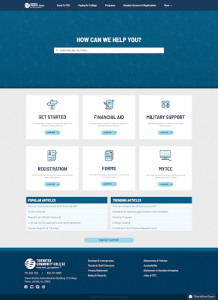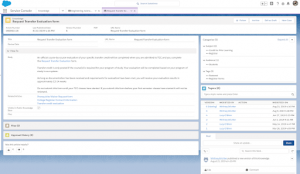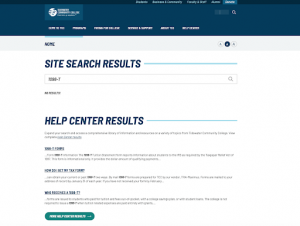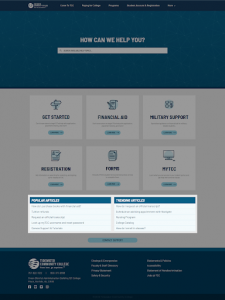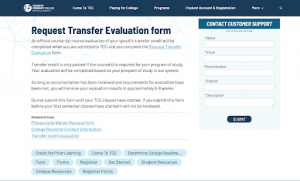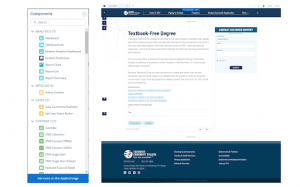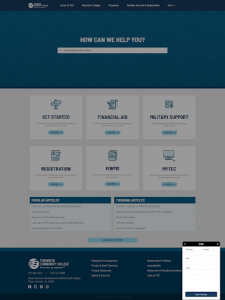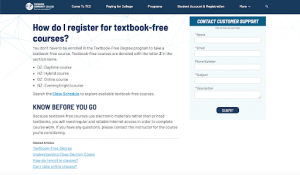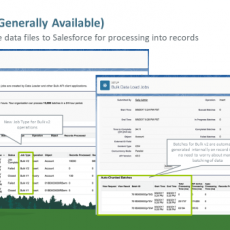Efficiency is key to meeting the needs of your students, especially when it comes to helping them navigate complex processes like transfer evaluation and enrollment. These procedures often rely on convoluted forms and complicated workflows to process student information – and staying on top of hundreds of student forms is a daunting, if not impossible, task for most colleges and universities.
However, by relying on Salesforce Knowledge and Communities to organize and optimize your student forms, you can centralize your form updates in one place, optimize your forms for search, meet all 508 compliance standards, and help students (and staff!) fast-track enrollment and cut through red tape 24/7!
A GROWING DEMAND FOR SELF-SERVICE
Since COVID-19 hit, more and more schools are taking their student support operations and recruitment efforts entirely online. That makes this the perfect time to take a step back and evaluate your remote service functions and explore opportunities to optimize and expand your student service and accessibility.
A knowledge base is a curated online resource that houses guides, tutorials, and answers to common questions, often accompanied with step-by-step instructions. Essentially, a knowledge base acts as a self-service portal which can be easily accessed by customers and internal employees alike to help answer questions and guide next steps. This is extremely helpful in reducing the number of times that students need to contact your support staff and in centralizing information as a valuable reference resource to your support staff.
At Tidewater Community College, we launched our knowledge base, known as the Help Center, with our newly redesigned website to help transform our interactions with prospective students.
According to recent data from Forrester about the future of customer service, 53% of US online adults are likely to abandon their online purchase if they can’t find a quick answer to their question and 73% say that valuing their time is the most important thing a company can do to provide them with good online customer service.
Today I’ll show you how to improve your level of student service by organizing your public student forms using Salesforce’s Knowledge and Communities features.
FOCUS ON SCALEABILITY & ACCESSIBILITY
Hard links and columns upon columns of links to .pdf forms don’t meet our student’s needs, often have compliance issues and can be a headache to update and keep current throughout the school year. Form names are often full of educational jargon that the public doesn’t understand – and large pages of links can be difficult to navigate, especially for those with disabilities.
By harnessing the power of Communities, you can easily build custom templates for these forms. These templates standardize how forms are presented online, sharing not just the form but also a description of what each form does and how or where to submit it. These templates can make organizing and maintaining hundreds (or thousands) of documents more manageable for your customer service team’s self-service strategy.
Because the data is updated for backend and frontend use, it simultaneously provides streamlined, current information to your internal support staff as well as your external user.
And this structure doesn’t just help your students and users, it provides a foundation for how you present all of your college or university forms to the public for completion.
When the time comes for a form change or update, you can upload a new file (and circulate for approval internally) to the article, without chasing hard links across a web property or worrying about redirects.
Best of all? Communities offers a drag-and-drop interface that doesn’t require a developer or technical expertise to implement.
INTUITIVE ORGANIZATION & OPTIMIZATION
When you’re transforming your forms (and other information) into a knowledge base, you should organize for your students first. A student attempting self-service is likely to be frustrated and trying to solve a problem. Don’t drive them crazy with overly complex or lengthy writing – use clear and concise language to explain what a form does and how to successfully complete and submit it.
It takes really strong, smart, and organized documentation to serve your customer base remotely. For instance, will students search for “enrollment” or “registration”? Is “GI Bill” more common language that “military education benefits”?
You should also work with your Marketing Team to leverage their insights into student behavior and language. At Tidewater Community College, we fully integrated real-time search results from our Help Center into our main site search at TCC.EDU to allow even more comprehensive form search and availability for our users.
We also offer a “popular” and “trending” article option on the Help Center homepage for visitors who might be looking for high-traffic articles or common forms/questions depending on the time of year.
It’s important to continue to refine your form organization by regularly reviewing keywords and search results and meeting with your student support staff to ensure that students are finding the forms they need with ease.
MEANINGFUL TAGS & CROSS-REFERENCING
Students should not have to read your entire knowledge base to find the form they need. With the right software and properly developed content, you can deliver information they need – when they need it.
One of the ways you can help users surface the information they need is by linking to relevant information inside of articles. In Salesforce, you can include inline links to other articles within your content.
There are also more advanced options for cross-referencing and tagging “similar” articles in the system, including category tags and Related Articles. These category tags serve as a secondary form of organization that can help students self-serve themselves through complicated processes via relevant, related help articles and topics.
In the TCC Help Center screenshot below, you can view all of these options in an article, including prominent tags and related article links to inquiries that are often associated with the selected form.
Your knowledge base could be filled with amazing content, but without a solid information architecture, that content will never live up to its self-service potential.
HAND-OFF TO STAFF SUPPORT
Now, a caveat. You cannot expect every student – or every form – to be solely self-service.
In situations where students are struggling with domicile or financial aid eligibility, processes can require such unique documentation depending on a student’s circumstance that your institution will want to make sure they can find one-on-one guidance prior to submitting their own paperwork.
Having a helpful knowledge base of forms that’s easily accessible is the first step, but colleges and universities will always need to offer a great support team for those problems that need a little extra help.
At Tidewater Community College, we facilitate this hand-off numerous ways – through Salesforce-powered Chat and an option to “Contact Customer Support” on every article, which opens a case for follow-up through our student support team.
Remember that the overall purpose of the help center is to help your students help themselves. In pursuit of that goal, you want to make finding one-on-one support easy and available.
CONCLUSION
Knowledge bases provide anticipatory service that reflects an institution’s commitment to their students in making complex student procedures and processes more accessible. Remember: to be successful you should always develop your information data architecture prior to building the tool and developing your content. You should also avoid adding any temporary or fleeting content to your knowledge base; these systems are designed for evergreen content that can be edited as needed – but should always be available. Lastly, make sure you are accurately representing a process or system; users will need to access information about how your institution’s processes actually work. If a process or form needs to be tweaked before going into your knowledge base flag it for update ahead of time and save yourself a lot of hassle in re-work later!
Take advantage of these tools to encourage student self-service and take the pressure off your service agents during peak times – all while you optimize your content and make information even easier to find!
Already established? Leverage your system’s reporting capabilities to identify gaps or pain points in your processes to improve your knowledge base content — and optimize your product or service!
Please subscribe
Subscribe to our mailing list and get tips to maximize salesforce to your email inbox.
I am honored to have your subscription. Stay tuned for tips to maximize your salesforce investment
Something went wrong.
